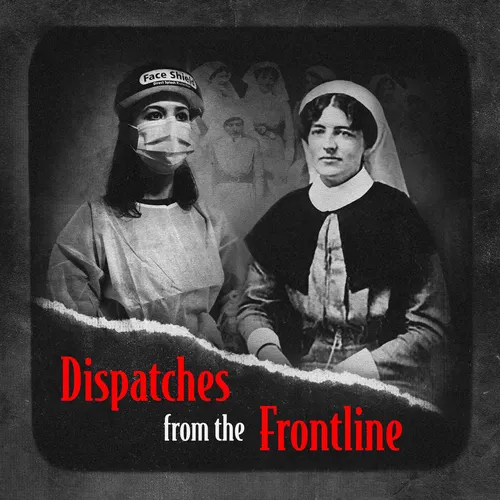Episode 12: 30th October, 1914
- Author
- Geraldine Cook-Dafner
- Published
- Fri 08 Jul 2022
- Episode Link
- https://shows.acast.com/dispatches-from-the-frontline/episodes/episode-12-30th-october-1914
The final diary entry for 29 October reads: “We were all working at high pressure because we knew there was fierce fighting, and wounded might come at any moment”. It is 1914 and we are half way through the podcasts. There is a gap from this entry on 30 October until 1916. The absent pages are a mystery to Nan Reay’s family.We can only surmise that either, she didn’t write her diary during that time because of the thousands of wounded arriving from the Somme or, the pages were lost in the many frenzied movement orders she had to follow to work at another AVH base, or possibly, she just couldn’t summon up the energy to deal with the daily atrocity she was facing. However, it is hard to imagine Nan Reay not writing her diary which had become almost like a “friend”.
Nan Reay’s fiancé was killed at the Battle of the Somme in 1916 and perhaps her grief was too near the surface for her to write when she was tending to thousands of dying and wounded soldiers day in and day out. We will never know.
Nan Reay writes in the margins: "Mentioned in Dispatches" Sir Douglas Haigh. NB The Battle of the Somme took place between 1 July and 18 November 1916. Mentioned in dispatches describes a member of the armed forces whose name appears in an official report written by a superior officer and sent to the high command, in which their gallant or meritorious action in the face of the enemy is described. We assume that Nan Reay’s fiancé, Lieut. Onslow was “mentioned in dispatches”.
Lieut. Onslow was awarded an M.C. posthumously on 22 September 1916: For conspicuous gallantry and coolness in leading his company in an attack until stopped by uncut wire and concentrated machine gun fire. He exposed himself, regardless of danger, in carrying in wounded.
The first day of the battle was one of the bloodiest on the Somme. On 1 July 1916, the British forces suffered 57,470 casualties, including 19,240 fatalities. They gained just three square miles of territory. By November 18th, more than 600,000 British and French soldiers were killed, wounded, or missing in the action. German casualties were more than 650,000. Total ground gained amounted to 125 square miles for the Allies.
On 14 July 1916, the Australian Voluntary Hospital ceased to exist. It was taken over by the Imperial Government and became No.32 Stationary Hospital British Expeditionary Force at Wimereux. Nan Reay and four others were asked to stay on and were transferred to the Queen Alexandra's Imperial Military Nursing Service Reserve. Nan Reay always considered No. 32 as her “home”. Wimereux is a coastal town situated five kms north of Boulogne.
For more information on Dispatches from the Frontline project, go to: www.dispatchesfromthefrontline.org
Dispatches from the Frontline is brought to you by:
Geraldine Cook-Dafner – Narrator
Naomi Edwards - Director
Alex Dafner – Voice recording and editing
Zoltan Fecso – Music composition, sound design and editing
Tristan Meecham – Creative Producer, All the Queen’s Men
Image – Sarah Corridon
Dispatches from the Frontline is supported by funding from the Public Record Office Victoria, Creative Victoria and Regional Arts Victoria
Hosted on Acast. See acast.com/privacy for more information.
